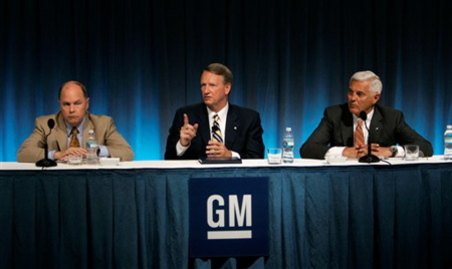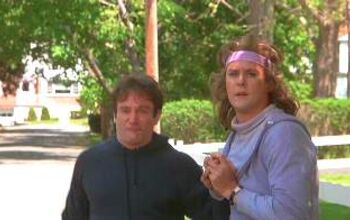Editorial: General Motors Zombie Watch 1: The World According to Fritz
GM CEO Fritz Henderson has filed a deposition with the federal bankruptcy court [ download here] pleading for a 363 motion that would create the “new” zombie GM from the corpse of old debt-ridden GM. “In the face of the global meltdown of the financial markets, and a liquidity crisis unprecedented in GM’s 100 year history, there is only one way to maximize the value and permit the survival of GM’s business and save hundreds of thousands of jobs associated with not only GM, but also its vast supplier and dealer networks: these chapter 11 cases and the prompt approval of the 363 Transaction.” While I don’t expect Fritz to say “GM has entered this crisis due to epic mismanagement of which I am a fundamental part,” it strikes me as odd that this blame avoidance arrives on page three. Isn’t it a bit early to say “it’s not our fault?” Apparently, early and often is the strategy here.
On page 5, again with the “it wuzzn’t me”:
Recent events, however — including both international competitive forces and the worldwide recession that has resulted in an economic contraction and dislocation not seen since the 1930s — have led to the dramatic financial distress of the world’s largest automotive company.
And again on page 6:
Most recently, GM’s sales have been materially affected by the overall decline in domestic automobile sales, which continued unabated given the deteriorating economy and financial markets. The Seasonally Adjusted Annual Rate (“SAAR”) of automobile sales for the United States industry declined from 15.6 million units in January 2008 to 9.8 million units in January 2009, which is the lowest level since 1982. This affected all domestic OEMs, but GM in particular.
And again on the bottom of page 6:
As a result of the economic crisis, in November 2008, the Company was compelled to seek financial assistance from the Federal Government.
And again on page 16:
While foreign OEMs enjoyed, among other advantages, lower wages and far lower annual healthcare and benefit costs, the Company’s obligation to support pension benefits and provide healthcare and life insurance benefits (OPEB) for its former employees increased exponentially, even as its revenues eroded because of a drop in market share and the downturn in the national and global economy.
And again on page 18:
Notwithstanding significant progress in cost reduction and increased efficiency, competitive pressure on GM was exacerbated by (i) substantial increases in the price of crude oil to nearly $150 per barrel during 2008, which precipitated a sharp downturn in driving and sales in the large vehicle segments in which GM was dominant and most profitable and (ii) a sharp decline in the global economy, including substantial increases in unemployment and a freeze-up of consumer and business lending. The resulting drop in new vehicle sales led to a steep erosion in GM revenues and, in turn, significant operating losses.
And again on page 19:
Even as fuel prices stabilized and moderated to some degree during the fall of 2008, the Company faced sharply deteriorating economic conditions during the second half of 2008 and the first quarter of 2009, which can only be characterized as the worst economic downturn and credit market environment since the Great Depression. Significant failures occurred in America’s financial sector — including the forced sale or liquidation of two of America’s five largest investment banks, the crippling of the nation’s largest insurance company, the conservatorships of both Freddie Mac and Fannie Mae, and the financial distress of two of the nation’s ten largest banks. The financial market crisis not only affected large institutions, but also affected consumers, as both income and financing for buyers and lessees of automobiles evaporated.
And again on page 21:
Thus, the combination of the sharp run-up of gasoline prices with its direct impact on the Company’s most profitable vehicle segments, rapid declines in the housing/mortgage/credit sectors, the freeze-up of equity and debt capital markets, and the lowest levels of consumer confidence in nearly thirty years, had an unprecedented effect on the automotive industry generally and GM in particular.
This is the same page that contains the money shot:
Under these extraordinary conditions, the Company’s liquidity rapidly eroded to a level below what was necessary to operate the business. Consequently, GM had no choice but to reach out to the U.S. Government for financial assistance.
And again on page 36:
As discussed below, the deepening economic crisis has affected not only GM, but also the thousands of direct and indirect suppliers and vendors that provide components, products, and material to the Company. In light of the credit crisis and the rapid decline in automobile sales, many of the Company’s suppliers are unable to access credit and are facing growing and serious uncertainty about the prospects for their businesses.
I don’t think this is spin. The zombie now known as Government Motors doesn’t even know why it died. Henderson and his minions continue to believe they’re victims of circumstance. Even worse, I’m not sure GM’s First Step in its $100 billion recovery program is important anymore—and not in the way that Motown’s zombie cheerleaders might imagine.
More by Robert Farago
Latest Car Reviews
Read moreLatest Product Reviews
Read moreRecent Comments
- MaintenanceCosts Poorly packaged, oddly proportioned small CUV with an unrefined hybrid powertrain and a luxury-market price? Who wouldn't want it?
- MaintenanceCosts Who knows whether it rides or handles acceptably or whether it chews up a set of tires in 5000 miles, but we definitely know it has a "mature stance."Sounds like JUST the kind of previous owner you'd want…
- 28-Cars-Later Nissan will be very fortunate to not be in the Japanese equivalent of Chapter 11 reorganization over the next 36 months, "getting rolling" is a luxury (also, I see what you did there).
- MaintenanceCosts RAM! RAM! RAM! ...... the child in the crosswalk that you can't see over the hood of this factory-lifted beast.
- 3-On-The-Tree Yes all the Older Land Cruiser’s and samurai’s have gone up here as well. I’ve taken both vehicle ps on some pretty rough roads exploring old mine shafts etc. I bought mine right before I deployed back in 08 and got it for $4000 and also bought another that is non running for parts, got a complete engine, drive train. The mice love it unfortunately.


































Comments
Join the conversation
Would GM's upper management really benefit from a giant Livejournal "I'm sooo soooo sorry" crying bitch fest? Besides, coming out and saying "We build total ass and have no clue what we're doing" may be charitable or moral in nature but would not really accomplish much (perhaps removal of the upper management maybe). Also, if GM specified a profitability target and missed it holy shit would there be hell to pay!
Who's to blame. One source of blame who the media has been avoiding is the US government. When Toyota and Honda set their assembly plants in the US, nobody gave the thought of how the domestics could survive long term when the domestic car makers were strung with about one million retirees. Toyota and Honda didn't have to pay a penny for health benefits or pension and to this day, still don't have that burden. This should have never been allowed especially when Japan has a functionally closed the doors for foreign car makers. That's why I always buy only American cars. If we don't buy American when the choice is there, we will not survive as a super power.